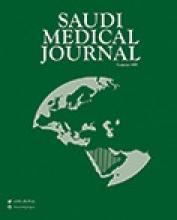Abstract
OBJECTIVE: To determine plasma fibrinogen and its correlates in the adult Saudi population and to investigate hyperfibrinogenemia as a possible risk factor for cardiovascular diseases (CVD).
METHODS: A cross-sectional survey was designed and carried out through multi-stage stratified cluster random sampling of every third house in 6 heterogeneously populated districts of Riyadh, Kingdom of Saudi Arabia, during the period 1999 to 2002. Demographic and clinical data of 2263 adult Saudi subjects, consisting of 1934 (85.5%) men and 329 (14.5%) women, was collected through a standard questionnaire. Body mass index (BMI), blood pressure (BP) and history of smoking were recorded. Plasma fibrinogen, total serum cholesterol, triglycerides, high density lipoproteins (HDL) and blood sugar were determined in fasting blood samples.
RESULTS: The majority (84.6%) of the subjects were between 20-50 years of age. The mean plasma fibrinogen was 336 +/- 115 mg/dl, and was increasing with age both in men and women. The mean +/- SD fibrinogen in women (357 +/- 118 mg/dl) was significantly higher (p value of 0.03) than men (332 +/- 114 mg/dl). Hyperfibrinogenemia (>400 mg/dl) was indicated in 554 (24.6%) of the total subjects. Among hyperfibrinogenemic Saudi adults, the prevalence of hypercholesterolemia was 14.3%, hypertriglyceridemia 24%, obesity 26.3%, systolic/diastolic hypertension 11.5% and 11% and hyperglycemia 26% (in women only). A reciprocal relation was observed between HDL and plasm fibrinogen. Significant positive correlation was seen between fibrinogen and BMI, systolic and diastolic BP and total cholesterol. There was no significant difference in the distribution of plasma fibrinogen between smokers and non-smokers (p value of 0.864). The difference in the magnitude of metabolic as well as modifiable CVD risk factors between smokers and non-smokers was not significant, except serum triglyceride which was significantly higher in smokers than non-smokers (p value of 0.020).
CONCLUSION: A significant positive correlation was observed between hyperfibrinogenemia and obesity, systolic/diastolic hypertension and hypercholesterolemia. Our results thus support the earlier reports that hyperfibrinogenemia is a potential CVD risk factor. Unlike other reports, we could not find any correlation between smoking and plasma fibrinogen in our studied subjects. The value of hyperfibrinogenemia as a definite risk factor for CVD has to be quantified in future case-control studies comparing its significance between CVD subjects and normal controls.
- Copyright: © Saudi Medical Journal
This is an open-access article distributed under the terms of the Creative Commons Attribution-Noncommercial-Share Alike 3.0 Unported, which permits unrestricted use, distribution, and reproduction in any medium, provided the original work is properly cited.






